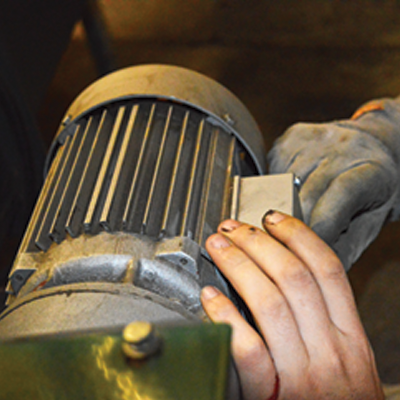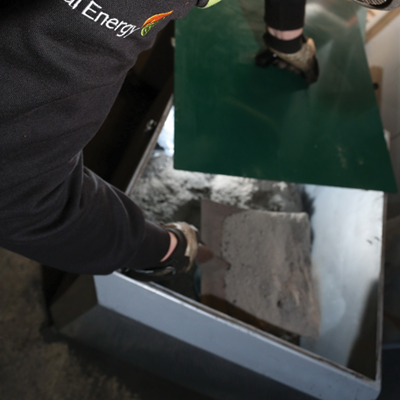09/03/2015
Watch your garden grow: 5 reasons to properly maintain your biomass boiler

A biomass boiler heating system is a sustainable, carbon reducing and cost saving solution for virtually any market segments you can think of. It typically offers cheaper fuel bills compared to LPG and oil as well as financial incentives from schemes such as the government’s Renewable Heat Incentive (RHI) whilst cutting your carbon footprint. These boilers run on renewable wood chip, wood pellets or logs which are often available from local sources.
However unlike your domestic gas boiler which you probably only look at once a year when you’ve just had an ice cold shower, a biomass system is more complex and requires a little more attention in order to run at its best.
It is always recommended that you have your biomass installation serviced by an experienced and fully trained engineer – for warranty of your boiler and certain incentive schemes, such as the government’s Renewable Heat Incentive (RHI), it is a requirement to continue receiving payments.
Throughout the year your biomass boiler needs a little more TLC than just a one-off check up. These maintenance steps are vital preventative measures to ensure your heating system is running at optimum efficiency and, most importantly, minimise the likelihood of faults and breakdowns.
1. CARE FOR YOUR INVESTMENT

Your new biomass system provides you with hot water and heating in a sustainable way. To ensure that it continues to provide a good quality of heating and that it remains safe, regular checks and maintenance are imperative.
When considering biomass it will have become clear that, unlike a domestic or commercial gas boiler, it is not a piece of technology that can simply be plugged in and left to run by its own devices. It needs care to ensure that it continues to operate at the best efficiencies possible so that you get the most out of your investment.
2. PREVENTATIVE MEASURES FOR YOUR PEACE OF MIND
Although there are weekly, regular and monthly maintenance documents relating to many biomass boilers, the fact is that most of what is contained in them are recommended checks: visually making sure that everything is running smoothly with your boiler is vitally important.
By isolating the boiler and checking the fire protection (FP) flap, combustion chamber, ash bins and so forth, you may notice things that could (if not taken care of) affect the boiler’s operation and efficiency over time.
A good example of this is clinker in the ash bins. Large chunks of unburnt wood fuel or solid, melted pieces of ash (known as clinker) could indicate an issue with the quality of your fuel. Fuel quality is typically one of the main factors in a boiler that has persistent glitches, faults or is not operating at the expected levels. It can often be easily rectified by testing the fuel to establish the quality and either re-commissioning the boiler to suit higher or lower quality of fuel or locating an alternative supplier.
If an issue is discovered that requires further expert attention, you can then arrange for a service engineer to visit the site. > Link service page 2
Don’t forget that you don’t just have to dump your ash appropriately – you can use it on your garden! Wood ash is a great source of potassium and some other trace elements, so why waste it when your plants, fruits and vegetables could benefit from the extra nutrients?
3. REQUIREMENTS TO RECEIVE FINANCIAL BENEFITS

If you are claiming the Renewable Heat Incentive (RHI), be it via the domestic or non-domestic scheme, you must comply with service and maintenance regulations of your biomass heating system.
Other schemes may have similar directives, so knowing the terms and conditions of your own payback or incentive structure is key to ensuring both you and your system are fully covered.
4. OPTIMISING YOUR INSTALLATION
To get the most out of your biomass boiler, the system needs to run at optimum levels. Not dealing with the maintenance required can lead to the boiler trying over compensating for issues such as the air holes in the combustion chambers not being cleaned properly or clinker gathering there and causing ash to build up.
These issues, simple as they are to prevent, can mean that your boiler will have to work harder to get the same amount of kilowatt heat to the buffer vessel. Now the boiler is using more energy than calculated, thereby making it less efficient and possibly affecting the site’s carbon footprint in the process. If not rectified quickly, energy bills could go up because of the increased use by the boiler.
5. HELPING YOUR BOILER GO THE DISTANCE
Taken proper care of, your biomass boiler could last as long as 30 years. So why would you want to risk cutting your boiler’s life span? You wouldn’t.
By carrying out the checks and simple maintenance laid out in your Operation and Maintenance (O&M) Manual, you are safeguarding your biomass boiler and fuel feed components from unwelcome issues, faults and breakdowns. This TLC will give your installation the best possible chance of providing you with sustainable heating and hot water for the next three decades with the minimal amount of repairs and replacements.
If you don’t have the time or staff to deal with the maintenance your biomass solution requires, Rural Energy offers monthly checks as part of their Service Contract bolt-ons. You can read more about our offerings here, or for a personal quote, call 0203 189 0666 or email service@ruralenergy.co.uk
- Agriculture (10)
- Awards (5)
- Carbon Reduction (26)
- Commercial (13)
- Country Estates (4)
- CSR (3)
- Design (4)
- District Heating (2)
- Domestic (2)
- Education & Healthcare (2)
- Events (11)
- Finance (3)
- Herz (9)
- Horticulture (3)
- Industrial (6)
- Installer Network (1)
- Poultry (4)
- Project Management (1)
- Public Sector (1)
- Renewable Heat Incentive (23)
- Service & Maintenance (3)
- Training (2)
- Warehouse (1)
- Wood Fuel (13)
- March 2018 (1)
- February 2018 (1)
- January 2018 (1)
- September 2017 (2)
- May 2016 (1)
- March 2016 (1)
- February 2016 (1)
- January 2016 (3)
- December 2015 (2)
- November 2015 (1)
- October 2015 (2)
- August 2015 (2)
- July 2015 (1)
- May 2015 (2)
- April 2015 (1)
- March 2015 (2)
- February 2015 (1)
- January 2015 (1)
- December 2014 (2)
- November 2014 (1)
- October 2014 (1)
- August 2014 (2)
- July 2014 (2)
- June 2014 (1)
- May 2014 (1)
- April 2014 (3)
- March 2014 (1)
- February 2014 (1)
- January 2014 (1)
- December 2013 (1)



